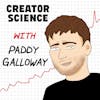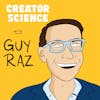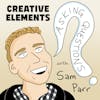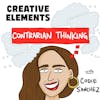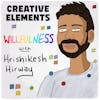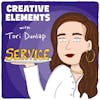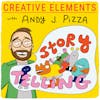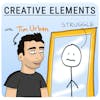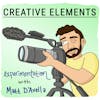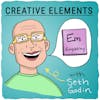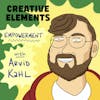
Arvid Kahl sold his SaaS company, FeedbackPanda, and is now a full-time creator as an author and course creator
Arvid Kahl is the creator of The Bootstrapped Founder. The Bootstrapped Founder is the home of his Twitter course Find your Following, the books Zero to Sold: How to Start, Run, and Sell a Bootstrapped Business and The Embedded Entrepreneur, which is an audience-driven book teaching you how to build an audience-driven business.
Previously, Arvid was the co-founder of FeedbackPanda, an online teacher productivity SaaS company, with my partner Danielle Simpson. FeedbackPanda was sold to SureSwift Capital in 2019.
In this episode, we talk about the start of FeedbackPanda, a speaking opportunity that opened up a new world for Arvid, the transition from founder to creator, his unconventional approach to Twitter, the difference between creating a course vs. books, and why he’s on a personal mission of Empowerment.
Join the Creative Companion Club
Subscribe to Creative Companion
Full transcript and show notes
***
SPONSORS
***
IF YOU LOVE CREATIVE ELEMENTS
Follow Creative Elements on Instagram
Subscribe to weekly episode emails
Leave a review on Apple Podcasts
***
ABOUT JAY CLOUSE
Subscribe to Creative Companion
***
FOR PODCASTERS
Enroll in my podcasting workshop
Enroll in my course on podcasting, Podcast Like The Pros
***
PODGLOMERATE NETWORK
This show is a part of the Podglomerate network, a company that produces, distributes, and monetizes podcasts. We encourage you to visit the website and sign up for our newsletter for more information about our shows, launches, and events. For more information on how The Podglomerate treats data, please see our Privacy Policy.
Since you're listening to Creative Elements, we'd like to suggest you also try other Podglomerate shows surrounding entrepreneurship, business, and careers like Rocketship.fm and Freelance to Founder.
Learn more about your ad choices. Visit megaphone.fm/adchoices
Arvid Kahl 00:00
One of the things that I tell everybody who asked me about a good strategy to build a twit audience is to completely forget writing tweets, standalone tweets, and to focus 100% on engaging with other people where they're already having a conversation.
Jay Clouse 00:15
Welcome to Creative elements, a show where we talk to your favorite creators and learn what it takes to make a living from your art and creativity. I'm your host, Jay Clouse. Let's start the show. Hello, my friend, welcome back to another episode of creative elements app to say I really felt the love last week with episode number 100. So many listeners reached out to congratulate me and thanked me, it was really something and not a single troll made fun of my on the spot singing of country music, so I'm glad for that as well. I also saw some new ratings and reviews on Spotify. So thank you to whoever took the time to leave a rating or review. And if you haven't done so yet, please do. I'm trying to get to 250 reviews on Apple podcasts and 100 ratings on Spotify. So no matter which phone you use, you can make a difference. I've also mentioned over the last few weeks that I'm working towards both video for the podcast, as well as some creative elements swag. So I wanted to put this out there. If you're a graphic designer and animator, a clothing designer, reach out to me I have a couple of projects that I would love some help with, you can contact me on the website creative elements.fm or send me an email Jay at Creative elements.fm. This week, we're back to interviewing other great creators and today I'm interviewing a bootstrapped software founder turn Creator, who has made a lot of waves by building in public. His name is Arvid Cole. And a few years ago, Arvid was putting his software engineering training to use by building a platform called feedback Panda, a platform that made it much easier and faster for teachers to provide feedback to their students.
Arvid Kahl 02:08
We solved the problem that every single teacher that was teaching for that school had was a critical problem. It was a current problem. Everybody had that at the same time, it was repeating people had that every day, it was just a perfect solution to a very, very critical problem that I found what we found by just watching us work. That's
Jay Clouse 02:27
Arvid. His partner Danielle was an English as a Second Language teacher. And he noticed her spending a lot of time doing administrative work outside of the classroom. So in an effort to spend more time with Danielle and to make her life easier, he decided to build some software as a side project.
Arvid Kahl 02:43
We started in 2017 in July, I think is when we really said early 2018 is when we went full time on it. And we sold it in July ish end of July 2019. I think I built the whole thing in a week or so the first product I know what you know, like a software engineer for decades, you kind of you learn how to build things fast.
Jay Clouse 03:04
So not only did Arvid build the software project in an incredibly short amount of time, but they even sold the company after just about two years in in those two years of building the platform of it. And Danielle attracted nearly 6000 teachers to the platform generating more than $50,000 in revenue per month. That's an incredible business. But for two founders who are running everything themselves, it was also a lot on their shoulders.
Arvid Kahl 03:31
I think honestly, I was at a point I was really close to burnout. I was probably mid burnout, thinking that I was close to burnout. You know how it is like you'll always have this perception of odd perfectly fine and look the fires burning around you. But yeah, I we sold for many reasons. Diversification was one of them. And me not being really able to deal with this anymore was another because I was the only we were two only two people we never hired during those two years, we had five and a half 1000 customers, but it was just two people running the business kind of stressful. If you asked me in retrospect, you know a lot of things I should have done different, but I was at a point where I really wanted to sell and then we sold that we went on a vacation. And then I got bored and I started writing well, and here I am.
Jay Clouse 04:14
Today Arvid is focused on being a solo creator. He has nearly 65,000 followers on Twitter, which he's gained almost entirely in the last couple of years. That's come on the back of writing two books, the embedded entrepreneur and 02 Sold. He also has a podcast called The bootstrapped founder and a new course on building your following on Twitter, which is called appropriately find your following of course that I've personally taken and highly recommend I actually have a discounted link in the show notes for listeners of the show to save 10% So in this episode, we talked about the start of feedback Panda, a speaking opportunity that opened up a new world for Arvid the transition from founder to creator, his unconventional approach to Twitter. The difference between creating a course versus creating a book Why he's on a personal mission of empowerment. I'd love to hear your thoughts on this episode. As you listen, you can find me on Twitter at Jay Clouse or on Instagram at Creative elements.fm tag me say hello, let me know that you're listening. And now let's talk with our bit
Arvid Kahl 05:22
Danielle was teaching English online because she said she, she needed a job. She she had like, a little accident. And she she couldn't walk well. And that meant she couldn't leave the house. And she's a trained opera singer, right. So she really needs to go places to perform, and she couldn't do anything. So she was kind of stuck at home. And that was before the pandemic. We're talking 2017 here where people were stuck at home involuntarily. And voluntarily. I mean, we're all kind of stuck at home involuntarily. But you know what I'm saying like she couldn't leave home. And she found a job teaching English online to Chinese kids like over the internet. And it was really cool. She could teach for hours and hours in a day. And she paid hourly and was actually quite nice. But then there was this part of her job that required her to fill out student feedback for the parents to read. Right. You know, like parents generally want to know what their kids are doing. And Chinese parents particularly want to know what their kids are doing. Because it's just a super cutthroat competitive landscape there. And learning English at an early age, Danielle had students like from the age of four to six starting to immerse themselves in the English language without having any training. It's pretty funny to watch her just like sing and dance in front of a computer. But that, that cost her a lot of time, like writing these reports cost her an hour, sometimes two hours, in addition to already having taught for 10 hours in a day. And I was I was at home once I was working half remotely have presents for German software company. I was a software engineer at the time. And I came home. And she was still doing the thing. She was doing the thing without actually teaching. She wasn't really paid for those two hours of additional work. But she had to do it to get paid for the 10 hours she taught before. It was frustrating. And I saw her built some kind of system that copy and pasting things, so she could reuse it because she was teaching the same lessons over and over to their kids. And having her own system, some Word documents, some Excel documents, and some of the fellow teachers had started like a Google sheet to deal with this. And then I just talked to her at some point and said, Hey, let's look into a solution. And then she found out a couple things about a software that we could use. And together, we built a prototype for her. She started using it, it immediately cut those two hours down to five minutes, because it was all automated copy and paste, template replacement stuff. I was software engineer, I loved building these kinds of things. And then since I had been building software service platforms for many years at that point, I had built her solution to quickly be able to be extended to a whole community of people had like Stripe integration for charging people money had like osseointegration for people to log in with their Facebook and stuff. It was all there. We turned it on. We responded to some comments that people had in a Facebook group, those teachers will all congregating in gigantic Facebook groups helping each other dealing with all the stress of that work. And people sign up. And I went from there like it wouldn't it weren't so fast that I hadn't even exchanged the test keys, the tests, login data for our Stripe account to the real production stuff. People wanted to subscribe and couldn't, because it was still trying to use the test data. It was awesome.
Jay Clouse 08:18
What year did that go public so that customers could actually start using it not just your wife,
Arvid Kahl 08:23
that was 2017. But I in writing a book about this whole thing because once we sold the company two years later, I had nothing to do. And I started writing a book, I figured out that one of the things that allowed me to do this in a week, it was just really reusing the same technology that I had been using for many years, both personally ended the job that I was currently in, because that kind of started as a moonlighting as a side project, right, I had a full time position that y'all had a full time job. And then I built the thing and late at night and over the weekend. And it just kind of turned into the software project that we kept running as a side project until it was making a five figure monthly recurring revenue situation so that we could easily quit our jobs and get into the same kind of financial compensation without having to kind of cut down our quality of life. So we waited for pretty much half a year, even though it was already profitable to quit our jobs. So yeah, it was so fast that I could build this because I had this immediate feedback cycle with Danielle, I would build something she would immediately use it. And I was using the exact same tech stack that I was using at work, which is all open source, right? Nobody's using kind of proprietary technology anymore. It's all Python or Ruby or something. So everybody can use this for side projects as well. And I was legally allowed to build side projects, which is very important for software engineers, because some businesses don't allow for anything as a side project or if you build something it belongs to the business you're working for. So I made sure I could actually do this had an agreement with the company I was working for. But yeah, that was fairly quick. And then we just continued to iterate on the product like for years until we sold it really because then yeah, well was always still a little bit of a teacher, she may have quit a job, but she was still trying to teach every now and then. And we always were in contact with the teacher. So we always had our Yeah, we were doing the dogfooding thing, right where you eat your own dog food. And we certainly did that for as long as we could.
Jay Clouse 10:14
Well, just to kind of close the loop. The timeline is fascinating to me, because two years is incredible for a SaaS company from development to six months in you were doing five figures of recurring revenue, where were things when you sold it two years later.
Arvid Kahl 10:26
So we had a monthly recurring revenue of just around $55,000. Yeah, and MRR that was with five and a half 1000 customers, you can kind of kind of guess what the monthly fee was there. But that was where we sold. And that allowed us to have what I am allowed to say is a life changing exit, which definitely changed my life because I'm sitting here in my basement, and I'm my own boss. And I've been doing this for the last couple years. So it's it's been really nice allowed us to do a lot of things that we wanted to do, we'd be moved from Europe, we were in Berlin at the time, which was awesome. Like, if you if you want to build something that bridges the North American teacher population with the Chinese children, like learner population, it's wonderful to be geographically right in the middle, right? That was cool, like middle of Europe, you had the late Chinese day, the early American Day, you had just, it was a great, great opportunity for us being at the right place quite literally at the right time. And then we moved from from that to Canada, where I am calling from today, like Danielle's family is Canadian. And she just put me in a little suitcase and brought me here. And now we live here in the countryside, which is wonderful here in Ontario. So that changed, we now have our own place. And we do what we want to do, really, we have our own little things I do. I'm a writer, I'm a course creator, I guess I'm a creator, that's kind of you know,
Jay Clouse 11:53
what they call it now you're wearing ConvertKit shirt, you're a creator,
Arvid Kahl 11:57
yes, teach everything, you know, it's one of my finest shirts. And I really love it, because I think this is exactly what I was meant to do. Always and just recently found out that I can or should, you know, like, we all have so much to share. But so many innovations, like the voice in our heads, voices notes that are telling us that why us? You know, like the imposter syndrome voices and are not qualified enough voices and whatever kind of weird voices that are not us, but we think they are going on in our heads. And yeah, ever since I found that on the shirt. It's like, oh, yeah, the shirt is telling me to do it. Well, I'm gonna wear the shirt. So you know, and then it really helps I use it in my course too. Because I feel it's just such a nice message to give people do teach everything, you know, it might not be much, but it's definitely more than what some other people know. Right. And it's probably way more than you think it is. Because we all have our unique experiences. And they all intersect in super interesting ways that other people have never thought about. So yeah, teaching is what I'm doing Danielle, this is a musician, she's going back into her musician roots, which is also awesome that building a SAS just, you know, a little little says on the side and then selling it and then you know, you can go back to what you wanted to do with your life in the first place. It's just a wonderful opportunity. And it was great fun, I learned a lot. And I share as much as I can from that experience. And I really appreciate that, that the opportunities that I get today, being able to talk to you about this. And knowing that there's probably a couple people listening to this, that's just wonderful. Because, you know, I can motivate people, I can give them the little tiny little boosts that they might need to get started. And that's just all I want to do in my life
Jay Clouse 13:38
will talk to me about this transition because this is this is where you came into my world was when I saw you doing the the teaching the building and public the writing. And it seems like you made a pretty seamless transition from selling this company and building SAS to now doing this online creator thing. And part of me wonders, did you wrestle it all with letting go of the identity of a SAS founder and moving into this new identity? Because that's hard for a lot of people who build a company. And that's like, all they know, and all they do for a couple of years to now transition into a different state of being?
Arvid Kahl 14:13
That's a very interesting question. Because I've I've thought about this a lot, particularly after we sold the business, I figured out that I found a lot of purpose in helping people. Right. And because not only was I doing the technical side of feedback when I'm building the whole product, that was fun. That was kind of my my train skill, the skill that I had acquired over building software and multiple languages for multiple companies of varying like stages of funding and you know, product market fit or whatever. I've been doing this since 2005 or something professionally as a software engineer. But that was my technical skill. What I what I found was much more interesting to me though, was helping people like realize their own ambition, whereas in our feedback panda world we were only to people, so we had to share everything right, we had to do everything together, we kind of tried to split responsibilities between us. Danielle was the CEO, she left the company, she led the design, she let the the customer outreach and understanding the customer customer success and stuff. But for customer service, helping them with the actual problems with the product, that was my job to kind of split that. But most of the time, I would be the first person to talk to people. And I discovered, to my surprise that as a self classifying introvert, I really enjoyed talking to people. Because the moment there's a purpose, the moment you can help them with something, you're not just like chatting about the weather, or you know, like trying to get to network or something, it wasn't really about that it was about solving their immediate issue with something that I could help them with. And that was enjoyable. I really, really liked that. And that was the thing that I miss most it wasn't the building part. There wasn't like maintaining a software product by myself. That was actually the stressful, Bernard causing situation that I had there, but and talking to people, having them chat about their day, because they were either frustrated or just happy to talk or whatever it was, that was awesome. And I went into a conversation, but they had a problem. And we left the conversation. They didn't have that problem anymore. Great feeling helping people sometimes just helping them help themselves figure out how to do things. That was where I found my love for what I now call empowerment, because that's really all I'm trying to do is to help people help themselves. Right with the books I write the course I have, what do you say create? So I'm still trying to figure out, yeah, of course I made I recorded in my basement. I want to give people the opportunity to figure something out and to do stuff themselves. Does that I figured that out at that point that this is actually what I liked. The whole my whole life, I was under the impression that I was really, really good at solving technical problems. But that was just like the tool that I was trained to use. And now I put found something to actually put it
Jay Clouse 16:56
to use for. After a quick break, Arvind, and I talk about the speaking opportunity that put him on the path to becoming an online creator. And later arbit shares his unconventional strategy for finding your following. So stick around, and we'll be right back. Welcome back to my conversation with Arvind Cole. We've talked a lot so far about the sale of arbites business feedback panda in the financial impact it had on his life. But besides that financial impact, it also opened the door to a speaking opportunity that put Arvid on an entirely new path.
Arvid Kahl 17:31
The company we sold to was called shore swift capital. And they are a private equity company that
Jay Clouse 17:35
has acquired know them. Yeah, those guys of course you
Arvid Kahl 17:38
do like the all over our industry, right? They they there's a lot of founders that sold to them, like Tyler Turing versus one of them more, it's that missing. I was one of them. And there's, there's a moment we sold to them. We talked to all these people to do our own due diligence on the people that we're going to be acquired by and they had, like glowing reviews that sounded very sincere. And then we actually went into the process with them and the due diligence that they did on us. Everything was wonderful. We had a really, really good time. It wasn't complicated. There were no like hiccups. All our lawyer said that the letter of intent and even though the purchasing agreement that they sent us was the most boring document he ever read, which for m&a lawyer is probably the biggest thumbs up you can get right? Because there was no hidden trapdoors, there was nothing, it was really good. And I'm not sponsored to say this, it was really just my experience. And that experience has extended to today. And they also sponsored microcurrent for Europe, the conference. That's why I'm saying this. They were a sponsor there. And they asked us why don't you want to come to the conference. And then at some point, they the conference itself was asking for guest speakers, if anybody wanted to spend like 10 minutes on stage, talk about whatever they wanted to talk about. And we submitted our little talk about how we sold feedback panda and what we did to make it sellable. And then we got on stage. So we got voted in by the the visitors or the people who wanted to wanted us to speak. So just months after we sold the company, Danielle and I were already on stage at a founder conference in within this community talking about our exit. And that immediately put us on the map. That's why my Twitter following was for hundreds. At the point where we sold the business like accumulated over 10 years, like painfully excruciatingly getting to 400 followers. And within a couple months, it was a couple 1000 people because I was I was just Yes successful enough to get a spot at the conference and lucky enough for people to trust me to provide something meaningful. And I put my face there that put Danielle's face there. We got to chat with all those the big weeks of the industry like Rob Walling, and you know, like everybody who's a big name in the indie hacker community, and that made the transition to Twitter easier, because that just gives you some credibility from the start. Yeah,
Jay Clouse 19:47
I hadn't planned to ask this but this is coming up for me. I would love to understand your like money story, because if I put myself in your shoes and I'm running a SASS company that's generating 55 Fish $1,000 per month. And now that's gone life changing. I said, That's awesome. There's probably still a part of me that almost expects to generate that type of revenue on a monthly basis no matter what I do now. And writing books, building courses, not the fastest way to get there. Did you have any struggles with that either? Like, did you change the way you thought about revenue and generating revenue? And is that important to you? Do you care?
Arvid Kahl 20:24
I was raised in a family that didn't have much money. And I was also raised in what is, I guess you can call it former Eastern Germany, which meant that my my parents and my grandparents were raised in a socialist and Soviet controlled area of Germany. So everything that we know that they knew about how the economy worked, ended in 1989, when Germany got reunified, right, I am German, by the way, just so everybody knows, German person. But that also meant that nobody really understood how to navigate the capital markets. Nobody understood what investment really is. Because in the socialist system, rent was like 10 bucks a month, everything was subsidized. Like the prices, my grandmother worked in the ministry of price, she set prices on the ministry, for cars in East Germany, it's the weirdest thing. Like you could not imagine that there was such a place, they would say, oh, yeah, butter is two bucks today or something. And it's just that that's how it works. So everything that they knew about money was very, very much non relevant for the new economy. I was born in 85. So they figured it out as I was growing up. And what they learned, they were quickly learning that people would scam you, like they the banks would try to sell you like super expensive mutual funds with like, yearly costs, exceed the gains you get from the fund, all that kind of stuff. Because you know, if you have a group of people that are gullible, that have no idea might just as well cheat them if you're an institution like that. So everything that I learned as a kid about money is don't invest, they're just gonna steal your money, and make enough money for you to pay things, but don't talk about it either. So essentially, it's everything wrong about investment is what I learned in my life. Because the moment you start talking about your situation, other people can help you, the moment you invest your money makes more money, right? Obviously, that's what it is, for me now that I've taught thought about it and talk to people about it. But I was raised. And I until I was like, in my mid 20s, didn't understand that it could be any different, which meant I didn't have much money. But when we started the business, and throughout building the business, that also meant that the business itself was the only valuable asset that I really had, like, I made some good salary on my software engineering income. And Danielle made some good money too. But we were living in Berlin, which has high rents, and we were living a interesting lifestyle, which didn't leave much for saving, again, was never taught how to do that either. And didn't really understand that I would have to. So when we then sold the business for again, life changing amount of money, everything changed. All of a sudden, we reached this plateau of financial independence, where we didn't need to work to make an income anymore, because but some even basic investments. And this is obviously not investment advice. But you know, ETFs, in the s&p 500, if you put a large enough amount of money in there, this generates as much revenue in a year as you would make from having a regular job. Right. So that is now covered. And that also meant in if you're, if I look at my own needs to make revenue that completely dropped off the picture for me, I was thinking, Okay, I might want to create some more passive income sources and the books in the course they are these things that I do consciously, but I'm not chasing income anymore. I don't need to, I don't want to, I don't want this to control my life. And I want to wake up whenever I want to wake up, which means I can't have a job. And I want to take days off when I want to take days off, which means I can't have a job. So all this kind of, you know, the necessity to make this amount of money again, it's over because we have a lump sum that is just making money for us. That doesn't mean I'm not looking into like increasing wealth for the family. But we do this differently. We are invested Otoniel. And I we are limited partners with the Colin company fund run by Tyler triggers, right? Who sold T shirts with capital, all the big family. He's investing or the fund is investing in Bootstrap businesses, which we know something about because we ran them I ran multiple into the ground before we ran one that actually sold but you know, we ran them in many different capacities. And both of them. I know something about this. So we invested and also mentors in that fund. Just yesterday, I had a call with somebody who is in the fund about what their says SAS businesses is going to be facing and kinds of challenges and the kinds of decisions that they're supposed to be making. I don't charge for these calls. Because I'm invested in these companies in some some capacity. It's just wonderful, because I can use my knowledge and help people who are just a couple of years behind me in that sense. At the same time. I'm trying to build what Daniel Vassallo would call a portfolio of small bets, right I wrote a couple of books about my experience with both feedback panda and building Sass, and then my experience with building an info product from inside the community, which is my the embedded entrepreneur. And then I kind of took that knowledge and turned that into a Twitter course, it's all a succession of stuff for me, and I'm just increasing the kind of opportunity surface of my life by putting little things out there. So money is not the central path. But money is still a part of it, I've just tried to think about it as little as I can, while generating just increasing this monthly passive income, you know, like level more and more over time, that's the idea.
Jay Clouse 25:37
I talked to a lot of freelancers. And money is such a big thing for them. And I try to tell them all the time, like, you know, it's often easier to attract projects, when you aren't trying to get projects, which is like a scary thing that you can't like just put on, especially if you are in a place where you're financially insecure. But it's true of clients. It's true of customers, when you're not focused on that as the thing and you make decisions for other reasons, usually, for the betterment of the people you are serving, then good things happen. But it's so hard for people to start with that mindset.
Arvid Kahl 26:15
Yeah, you have the you always have the problem that instant gratification is such a strong motivating factor, right, I want to do the thing, and I want to do it now. And I will put will put all my efforts into trying to get to this as fast as I can. And obviously that is short term thinking that's like, you know that there's this book called Finite and Infinite games, right. And then there's a newer book by Simon Sinek, just called the infinite game, where he puts us into a more popularized way of investing. But the idea is, really, there's two kinds of things you can do, you can play a finite game with known players. And you know, the wind conditions, you know, that if there's a winner, there's a loser. And that's kind of what a soccer match or like a tennis match would be, right? There's strict rules, you know, exactly who's playing and after 90 minutes, or after six sets of something, the thing is over. And those things you optimize for by doing short term wins, right, you play as hard as you can to defeat your opponent to get to that trophy. And then on the other side, there's infinite games, like the game of love, or the game of life, or the game of politics, or the the game of economics, you cannot win politics just as much as you can't win economics, you can win an election, and you can win the merger, or you can win a client, but you can't win money, right? Like, these are just concepts where the idea of the infinite game is you win it by keeping playing the game is politics, probably one of the best examples to people who are good at politics, politicians, you may like them or not, doesn't really matter. They don't they win when they keep being politicians in power, right? Power is one of those games. So in a sense, politics probably is the worst example for an infinite game, because you have these, there's this distinction between the people who actually gain from it and who don't. But if you look at our community, in the hackers, people building businesses, business is one of those infinite games, you can't win business. And you do much better by keeping running businesses and helping other people's building their own businesses and building connections and partnerships than by trying to out price a competitor or by ruining somebody else's business, right. It's an a, it's a win win situation that you're looking into. And that's what infinite games are about.
Jay Clouse 28:23
And most of the people listen to this show. Their creators are content creators, which is even more of an infinite game. That's just something that you know, you write a great blog post that does really well, awesome. That's now attracting more people to your work, but you can't stop writing, because now those people want to learn from you. They want to hear from you. It's like the ultimate.
Arvid Kahl 28:41
Yeah, it's a great, great accountability thing as well. If people if people expect something from you, it makes you provide that more reliably. And that's kind of why I have a newsletter and a podcast. It's not that I always wanted to have a podcast I just figured out after I started writing, and I started with a blog, right, I have a blog called the bootstrap founder because it was a good soprano. And I thought, well, name seems to fit. And I started writing in like November 2019, and a couple of people liked it. And I figured out if I really want to keep writing this every week, I better find a way to stay accountable. So I put out a newsletter and the first person that subscribed it was like, Okay, I guess I have to show up next Friday. Doesn't matter if it's just one person that wants to read what I'm saying. They put in their email, they trust me enough to give me their private information. Now I need to commit just this week, I think episode 123 every single week, and it keeps me going because I know there's people who expect something of me. And in a way, that is the long term win the witness that every week, there's a couple of dozen more people that subscribe to my newsletter. And every week there's a couple more people that listen to my podcast that find me on Twitter that find my work, they may look at it, they may purchase they may not it doesn't matter to me, because I know eventually, either they will in the future or they will tell somebody else about me and they will get one of my books. It doesn't matter. I don't need them when right now. All I want to do is to gather as many people that I want to be communicating with around me, and give them the opportunity to find something valuable in the things that I already provide for free. So that eventually, there's reciprocity that they can help, right. And in my course, I have a little site called eventual reverse reciprocity, which is this kind of just human urge to, to get even. And if somebody gives you so much stuff for free, at some point in your life, you can't help but try to give back because it's just feels wrong. If you're not a psychopath, to not give back, right. If somebody gives me something for free every single day, eventually, I'm going to try to I don't know, mow their lawn or something, because I really want to give back. And it's the same for the greater economy, the more you put out there for free, the more you share, the more you help people increase this surface of opportunity around you, by people noticing, oh, this person super helpful, the more they will eventually feel compelled to help you back. And that can be monetary that can be by giving you a great opportunity, giving you a potentially a great gig as Freelancer a great job that you can start or a great partnership with somebody else, a shout out on somebody's twitter feed that has millions of followers, whatever it is, it's not just about money, it's about exposure, it's about being seen about being noticed about being helped to being seen as a helpful person. That makes all the difference. But the problem is, and that's that's kind of pulling it back to what you said initially. That is deferred gratification, that takes a long time, they did come take days, if you're lucky, that could take weeks or months if you're neutrally lucky. And it can take years if you're not lucky. But it will eventually happen. Just the chances are nonzero, it just might take a pretty long time. And for you to be able to sustain your life throughout this time, you need to have a way to generate money, right. And that's for most freelancers means they have to do jobs, they don't want to do or they have to look for clients, even though they would rather have clients come in. I think it's a very unique personal situation. But just having the mindset of if I put stuff out for free, eventually things will come back to me. That is the all you need to start.
Jay Clouse 32:02
When we come back, Harvard blows my mind with his different approach to growing on Twitter, and the differences he seen in selling courses versus selling books. Right after this. Welcome back. Earlier in the conversation, Arvind mentioned that before his talk at microcopy. Europe, he had spent 10 years on Twitter, building a following of about 400 people. At the time of this interview. Arvid was over 50,000 followers. So I asked him to help fill that gap between that event in 2021. And today, so we can understand when and how that growth actually happened? Well, funny
Arvid Kahl 32:36
enough, if you look at my Twitter growth, it is a very, very sustained line. Like if there's no spikes in there, it just slowly creeps up. And I remember that like feature panel was the same way, we didn't have this gigantic spike of new customers, we just had a couple of customers and then two customers a day turned into three customers today. And then three turns into four. And that turned into five, my Twitter growth is the exact same thing. In the beginning, I had like one or two new followers a day and then there was five, and then there was 10. And now I'm somewhere between 180 to 240 every day. And I think one thing that really helps is to offer a product or be someone who people want to talk to their peers about like the kind of being referral is kind of being shareable both as a product that you create or as a personality that you are, that makes a whole whole lot of difference. Like if you're if you're an aggressive person on Twitter, that is always sarcastic and always like beating down on people for their ideas that you don't believe right? People will not want to share you, they don't want to talk about you, they might want to follow you because they love to see the accidents happen. But they won't want to affiliate themselves with you. But if you're and that is obviously my self perception if you're if you're a kind and helpful person. And I want to be that and I try to be that every day, well, then people want to associate with you. Because they also want to be kind and helpful, who doesn't want to be kind and helpful in the community that is essentially the most supportive and that kind of community that I've ever seen anywhere. Just like the indie founder in the hacker community, the greater economy, community, everyone around in these two communities, and the intersecting parts of it is just so helpful to each other. And if you if you want to be part of that community, you look at the you look for the people who are like this, and I try to be like this. So I attract people. And if you attract 10 people, five of them might tell their friends, if you attract 20 people, 10 of them might tell their friends, so it's all a numbers game. And it's the cumulative effect, right? It's the compound effect of this, that caused this, these 50,000 followers to happen. I still cannot believe this. Honestly, I really have no idea how this happened. But I just show up on Twitter every day. I try to celebrate as many other people as I can instead of just talking about my own stuff. I think my my retweet to tweet ratio is somewhere around the 8020. Like I retweet A lot compared to what I actually talk, talk about my own stuff. Because I feel with a growing audience, everything I do to highlight somebody else can make their life so much better. Right? If somebody just starts that project, and now they exposed to 50,000 people that can make the whole difference for the start of the journey, or they have a question that I expose them to 50,000 different answers. Yeah, they could learn something from that. So I'm kind of using my leverage as somebody with a huge or somewhat large audience, I don't know. I think I'm still around the 250 1000s position, in terms of people's audience size on Twitter, like Social Blade, the website ranks you for that. And I still have a B minus with my audience. It's unfortunate, but I don't I haven't checked the last couple days, maybe a b by this void. But you know, I there's still 250,000 People that have larger audiences that I on Twitter, but I still believe 50,000 people is a lot, particularly since the all founders so you're all so exposing anything to a gigantic community of founders. And that, that makes all the difference. And that's what I do all day. Honestly, I just spend so much time on Twitter, trying to find cool things to share with everybody else so that the people who share it, get something out of it.
Jay Clouse 36:11
Most of the time, when I talked to people who are doing really well on Twitter, I'm like what's working and they pull out a bullhorn, and they say, threads, write threads all day, all you do is write threads. If I said Arvid, you have one hour a day that you can spend on Twitter and use your strategy, how would you divvy up that hour in how you're spending it?
Arvid Kahl 36:33
So I would write zero threads? Probably. Honestly, I am not a sweat fan. Because I I, to me, Twitter is about engagement. Like one of the things that I tell everybody who asked me about a good strategy to build a twitch audience is to completely forget writing tweets, standalone tweets, and to focus 100% on engaging with other people while they're already having a conversation. Because I still enjoy this to this day, I see somebody having a chat with somebody else. And they exchange something to discuss something and I go in there and give my opinion, or I pull in another expert that I know can help here or a find a resource and they put it in there in an ongoing conversation, I don't start a new conversation, I go to where it's already happening. And if you don't have a following, right, if you if you only have like 20 or 30 followers, when you start out on Twitter, like if you write a tweet, that's only 20 or 30, people are going to see it and even then, like what Twitter's algorithm only, like 10% of those people will see it anyway, on their streams, because there's so much other things that are trying to compete for their attention from people with a larger following that has more engagement. So when you write something with only 30 followers, three people might see it. And out of these three people. How many do you think was going to like fit the perfect engagement profile? Probably zero. So nobody will like it, nobody will engage with it. But if you go to somebody else's tweets, an influencer in the community that you like that you admire somebody who you want to be like, they have a couple 1000 followers, maybe a couple dozen, the 1000 followers, and they tweet about something. And you join that conversation where not only do you get to potentially engage with this follower you like, but with that gigantic audience of pre selected people that are exactly like you. Like, why would you choose to tweet into the void for your three people that's gonna be reading it. If there's an audience of 10s of 1000s of people that are so much more like the people that you actually want to have connect with you. Right, they're waiting for somebody to engage with them. So that's what I would spend my hour on, I would go into as many interesting conversations as possible, that I have something meaningful to contribute to not just to be a replay guy, that kind of sucks. But you know, like anything where I think I have something meaningful and valuable to add. And then I just engage. And if you do this for a long time, if you do this enough, one day, one hour a day for like a couple of weeks, you will amass a critical number of people following you that you can now start starting these conversations, you can now be the person giving their opinion for other people to engage with. But that is later talk, the beginning is 100% engagement. Don't look at threats, don't look at polls, don't look at spaces, don't look at nothing, but going into people's conversations, and giving them something that attracts other people to you. I call this the audience audition, you go there and you audition in front of somebody else's audience, because you're somebody that they might also want to follow. You don't plug your product, you don't talk about yourself, you give them something helpful. So they think oh, this person is helpful. I want to follow them because they might be useful to me.
Jay Clouse 39:30
So awesome. And that's that means a lot coming for somebody that does have a following of 50,000 people to say I still am doing these audience auditions rather than starting my own conversations and finding other conversations. I want to transition a little bit into some of the products that you've created now. You've written in published self published two books zero to sold and the embedded entrepreneur. And just as last week As of recording this you released I think your first course the Twitter course. Okay, so now having released those three products, as A teacher Arvid? How would you decide whether or not you do a book versus a course for a future idea that you want to teach somebody?
Arvid Kahl 40:09
You know, that is actually super hard to answer because like, this course, is my experimentation with the new format. Because books I know books because I'm an avid reader, I love reading, ever since I was a kid always, always read because I, yeah, I'm an only child. So I didn't have any people to spend my time with, which was books. And I read a lot during my time as a software engineer, which really helped me get to a point where I understood how to build a business from that, right, I read books, like the four hour workweek and Built to Sell and the E Myth, like all these foundational books for founders or reballing, starts with small stay small, like, you know, the books from our community. So I know what books are, and don't know how books work. And as a writer, and I never considered myself to be a writer until I started writing. But as people notice my writing and kind of resonated with it. At some point, I turned on my writing a couple months into writing into like, a guide, a free guide. And then people told me I would pay for this. And I said, Oh, maybe I should write a book. And then I can expand on that until, honestly, I and you know what the wonderful thing is, the person that I can attribute this to is Andrew Gus Deki, the founder of MIKO acquire, which is now doing such an amazing job of giving people in our community, the option to be acquired with a little SAS businesses little or not so little right, there is all kinds of businesses and Andrew I recently found this for my course too. It's in the course, he was one of the people that commented on my my launch third for the free guide that I put out there said, Hey, I would preorder this if there was a book. And this is such an empowering move by an established founder, that you see somebody making content that is kind of cool. But I at the time didn't know that I was a writer, I was just a blogger. And again, just isn't it's not mean qualitatively. It's just I felt I was not a book author, right. And Andrews, like, I buy that book. And that got me thinking, like, Okay, if people tell me they would buy this as a book, maybe should consider writing a book. And then I just, you know, spent the time and flesh it out into an actual book, which is now 500 pages. And you can do probably, like, you could lift with that you could do weight exercises with that book, it sets a pretty, pretty sizable book like that. See, what you sold is that book, like my story of building feedback, Panda, everything I learned but building a SAS in that book, because I first started on my blog, and then I, everything I knew I put into writing, for me that the process of writing is very clarifying. If you put me in front of a camera and want me to talk, I'm all over the place. And you've probably noticed this in this conversation, I pull in things from all over, because my memory is just very, you know, squirrel squirrel brain is I think what they call it, but in writing, you have to funnel it into something that is actually connected with each other. And writing, rewriting, editing, that really helps me put my thoughts into order. So I wrote that book. Then I wrote another book on the process of embedding yourself in the community and building a business from there, Twitter being that community, because that's my experience. And I wrote that book in public too, in my Twitter community, because I wanted to show the learnings of the book in the book. And that was very, very meta. That's the better entrepreneur that worked super well. I had like 500 beta readers, it was really cool. What a great experience. But after I was done with that, I was like, Huh, I guess I write another book now. And then I started thinking about writing a book about building and public. And in gathering this, the resources I needed for that, I thought seems to be such an actual actionable topic. Such a thing that it reading about is probably fine. But seeing it having somebody actually explain it to you might be easier. And then I saw people around me making courses like you have Kavon Xiang who's who's also like a big building public person, and he has a little course going and you have Kp and he's working with audience see, and that's a on deck, right? They were they have to know code fellowship that he worked with and on deck in general, he has a lot of interesting cohort based courses. So I was kind of pulled into the course world through the building and public movement. And then I thought, hey, I have an iPhone. And I have some some money to invest into good equipment into good lights or something. So why don't I make a course. And the great thing about making a course was there's a thing called a teleprompter. And for a writer, that is wonderful because I wrote out the script for my course, which is four and a half hours long, is 42,000 words of a script. And I put that on my other iPhone, and it's a one of these fancy iPhone teleprompters, but one is the camera and one is the little teleprompter and source and I just narrated my own script into my camera for four and a half hours and ended up with a course in front of a green screen. with some good sound equipment and good lighting that Danielle helped me with, because she has an eye for detail, well, I did not. That was just really how that course happened. But just from I want to write a book about building in public, too, I guess I better talk to people about it, too, I have a spot in our unfinished basement where I can put up a green screen. And that's the all. That's all that is, it's an experiment on changing the medium into something that is more compatible with the people that are consuming it. I know that people love to read. And you could probably read the book faster the 42,000 words than I narrated to you, but being able to give examples showing tweets and showing graphs and all that stuff and explaining them in detail, so much easier in a course. So now I want to answer your actual question, I probably would go for another course, because I just enjoyed more than writing a book because it is writing a book plus the actual instructional part, I talked about it in the course as well. Having a human person, like a face and a voice to connect with is also something that is much stronger for your brand. Like nobody who went through this course for four and a half hours is ever going to forget my face for good or bad. You know, like, if you read a book, you know, if you don't know the voice of the author, you might know their name or something, but you don't connect with them on a personal level. But you if you see your face, and I make a really lame joke, or something like that, never gonna leave you. And for retention sake, that's kind of good. From a business perspective. It's also interesting to write. But yeah, that's that I would always go with a course because I can always turn the course into a book. In retrospect, I have my script right here, I could just change it up, put a couple pictures in a book and then send it out to my self publishing KDP account and that it would be a book.
Jay Clouse 46:42
People also tend to value courses more highly, even though they often require less work to produce. So I charged 35 to $50 for the course. And a book, like if you charge more than $20 for a book people are like, Ah,
Arvid Kahl 46:59
it's so odd to have this kind of traditional understanding of what books are, like the amount of money I had to spend to get the book, the first book and the second book into the shape that people would accept it, which is you need to well designed cover, you need a proofreader, you need an editor, you need like maybe a some person that does the whole layouting and everything, right, I did all of most of these things by myself or crowdsourcing it or using tools. But I think even for the audiobook, I turned both of them into audiobooks. I paid like 3000 $5,000, to have somebody narrate that book as an audiobook. Meanwhile, I was sitting like two meters from where I'm sitting right now narrating my course into my own camera phone. Right? Having a tiny little mic doing barely any editing, because I had a script that I'm after 120 episodes of a podcast where a read from a script, I'm pretty good at reading from a script. So there was I think I spent half an hour actually editing those those, those five hours or four and a half hours of audio and stuff. It was just so much easier. And my editing cost I think I did, I built this in public today, I shared all the from the start, like what I was doing all the research material and my problems, my thoughts, my decisions, everything is is out there on Twitter, I did a little list of how much money I spent actually creating this course. And minus the time that I spent on it, because I have a hard time quantifying how much that is actually worth the actual tooling and the machinery, I needed to buy the lights and all that stuff that went two and a half $1,000. That was really it. And that is the software that I use, like Adobe Creative Suite and all that stuff, all these things are in there. So the books cost me like eight or 9000 to make and a wild. Do you know I still sold way more than that at this point. But the course cost me two and a half. And I think on my first day of launching the course, was it like like six and a half like $6.5 thousand is what I made on the first day of launching the course. So I had my initial cost minus my own labor, which is probably another four or five. I had that on the first day. And now that the first week is over, I think we are now as we're recording this 10 days into sales for find your following. I think I'm around 10 or $11,000 us in sales. So this is pretty solid can tell you that. And as a passive income generating thing. I'm looking forward to seeing the next couple of months of that and yours too, because I'm also going into affiliate marketing. For some I'm ever doing this, like having people that I know and trust affiliates be affiliates for my course. And I'm going to share stuff on Twitter like about the ongoing sales and just parts of the course to get people interested. It's just, it's just exciting. But I also completely agree. People value video based stuff much more than books for some reason, even though books require much more work and are super hard to change to like you can't change somebody's book on the shelf but you can always upload a new file to something it's It's weird, I think it's just the decades if not millennia of people having books. Right now we're centuries, I guess, of people interacting with books that set these kind of rigid expectations, while with digital content, everything is still kind of in flux, like the quality, how things are structured, it feels like everybody's doing their own thing. I had no idea what I was doing. And people tell me, it's a really good course. Like, okay, thank you very much, I guess I'm not too wrong. That's all I'm trying to be is to be not as wrong as possible. But a little bit less wrong than that, in doing this, but people tell me, the course is well structured. And I guess that is attributable to me writing it out in the first place, doing an editing pass, putting slides in with the writing, like just I spent 21 days writing, one day recording, and three days editing. That's how the course happened. So that's the distribution of effort that went into this. And that is super enjoyable to me. Because if that is what I can do in a month, cool, I'm gonna do that next month. With another topic. It's just yeah, it's just super enjoyable.
Jay Clouse 51:07
Something you did with that course that I've never quite seen before. And I'm curious to see 10 days and how you're feeling about this, you put it on four different platforms, you have it on podia, to sell it on your own domain, you have it on Gumroad, you have it on Udemy, and you have it on Skillshare. How's that experiment playing out?
Arvid Kahl 51:22
What I've learned is that some people get very confused by this, the fact that there's four different choices, which I had to change my landing page I had two offers in the beginning, right, if you if you go to the landing page for find your following you what you would have seen two big buttons, one is bitis on Gumroad. The other one was buy this on Podio. And then a little text base link under there also available on Udemy and Skillshare, I have changed the sense to buy this on Gumroad as being the only button and also available in Podio, Skillshare, and Udemy. And the more platforms I will edit to in the future for some reason, they will also be in that little list of text, people are confused by choice, because they expect products to have one place where you get them. But with a course and a particular course about a topic like Twitter, I guess empathetic Twitter, like being a kind and authentic person on Twitter. That's the whole point of the course, that is a very broad topic in the sense. And that also has appeal to many different people. And many different people have many different preferences. And that's the whole reason why it's available on different platforms. I know people from the indie hacker community, they love their downloadable video files, so it's on Gumroad for that reason. Also, I am a fan of Gumroad Gumroad is has been really helpful for all my other sales. So I want to stick with that they have a great coupon infrastructure, they have a great control about the email lists and stuff that you keep the people that subscribe, it's wonderful. They're good integrations and whatnot. I'm also not sponsored for that should be, but I'm not. That's why that's on Gumroad. It's on Podio. Because I always wanted to try Podio honestly, just my own decision, I like this platform, it's really cool. It only has a monthly fee. But people can subscribe to the course that they can watch it in really nice steps. And you can add little documents and stuff. It's a great platform. And then I put it on Udemy and Skillshare. Because I want reach, like reach is really important for a product that I consider to be a good product. Like all my products, I may be a self aggrandizing way I think they're good products. But you know, people tell me they're nice, so I believe them. I want this to be available to as many people as possible, which is why it's on Udemy I don't have much control of a price on Udemy. Unfortunately, because Udemy is somewhat almost predatory in terms of how they price things just for their own reasons. But I still wanted it to be there to be reachable. And it's on Skillshare because I heard people is telling me Skillshare is a nice platform for professionals to learn from. And honestly all experimental, like Skillshare Udemy is just me trying to figure out how Udemy and Skillshare works in terms of compensation and reach and how marketing works affiliates work on that platform. I put this on four different platforms because I know that people have different priorities and different preferences. I want to talk about one thing Dubai will do tomorrow and tomorrow whenever this airs is probably already over. Yes, I decided that this is not enough in terms of making the course available to many people because I know I have a large audience in countries that have whose currency is pretty much undervalued against the dollar right I charge in US dollars because status where most of the in the hacker community is originating you would think but it's really not. There's a lot of Indians, people from India, people from Southeast Asia, people from Australia, from Europe all over the place. And every country has differently valued currency but I still only charged in US dollars. So what I will turn on just a couple of hours from recording this actually is purchasing power parity pricing. So I will price all my courses on all platforms that support it with a with a discount towards the currency that people purchase the course and so if you're from India, I think it's somewhere 40 50% off. If you're from I don't know Slovenia it's probably 20% off that and stuff, if you're from the States, it's 0% off, because that's the dollar from Canada like 10% off, I don't really know, parody bar. So it's a program that I put on my landing page will do this for me. Platforms are currently support, those are Gumroad, and Podio. Because I can put coupons there and do this Udemy does not Skillshare does not allow me to do this, unfortunately. So if people want to be received the benefits of purchasing power parity pricing, which is a mouthful, they can go to Gumroad. And to podia. For this, I want to do this because I feel I owe this to my audience, which is a global audience to be cognizant of, that not everybody is making a US salary. And I am pricing this out of reach for whole economies, if I keep the price at 50 bucks us. So that's my experiment. That's also what I'm writing about this week, it's kind of going through my concerns that I had about it. And I'm launching this at the same time. And that will hopefully make this much more available to people from from other countries, and then create more buzz around the course, as being one of the few that is actually available to them in those countries.
Jay Clouse 56:04
Amazing. Goes back to your value of empowerment.
Arvid Kahl 56:07
Yeah, really. Because when you look at everything that you do, through a core value like this, you can't help but actually do it because you don't have any arguments against it. Like my initial arguments against it, were like, Oh, I'm gonna make less money, maybe if people pay less money for it. And I was like, Yeah, sure. But there's also so much more reach and I can help so much more people. And isn't that worth? It? Isn't? Isn't that worth more than a couple more dollars a month? And people might abuse it? They might act like they're from a different country. But yeah, sure, but people who do this, are these two people I want to serve anyway, like, would they even pay the full price for this, if they if they didn't get to cheat? Like all these arguments you can make against this, if you're looking at it through the lens of a core value, empowerment, or enabling people to solve their own problems, or you know, whatever it is lifting people up, you can't help but actually commit to the stuff, which really helps. And it's also part of the course finding this core value is one of the first things that you do in the Twitter course is to figure out what you are about, so you can use it in everything you do. Because I found that is super, super instructive for me. Once I figured out that I want to empower people that I want to engage with people as much as I can I want to connect people well makes makes it very easy to choose between retweeting somebody's tweet or like celebrating my own success. Always gonna go for somebody else, because that is what empowerment is about.
Jay Clouse 57:29
arbors advice for focusing on contributing to existing conversations on Twitter has been rattling around my brain since this interview. It's so counter to all the other advice we've heard on this show. Not that it makes the other advice of writing threads wrong, but it's so refreshing to hear a different strategy for the same goal. If you want to learn more about arbit you can visit his website at the bootstrapped founder.com Or at Arvid Cole on Twitter. And if you want to take his find your following course for Twitter, listeners of the show can save 10% links to that and everything mentioned are in the show notes. Thanks to Arvid for being on the show. Thank you to Emily Klaus for making the artwork for this episode. Thanks to Nathan Todhunter for mixing the show and Brian skill for creating our music. If you like this episode, you can tweet at Jay Clouse and let me know and if you really want to say thank you, please leave a review on Apple podcasts or Spotify, trying to hit a couple milestones there. So please take a minute to do so. Thanks for listening, and I'll talk to you next week. A Sonic universe
Most Popular Episodes
New to the show? Check out some of our most popular episodes.








